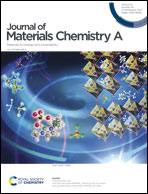A novel ionic liquid-based electrolyte assisting the high performance of low-temperature supercapacitors†
Abstract
Tailoring electrolyte components is an effective solution for building supercapacitors that can provide stable performance at low temperature, where traditional energy storage devices fail to operate. In this work, we propose a novel electrolyte with high low-temperature ion conductivity (2.46 mS cm−1 at −70 °C) by dissolving a low melting point ionic liquid, 1-propyl-3-methylimidazolium bis(trifluoromethanesulfonyl)imide (PMImNTf2), into a binary organic solvent of acetonitrile (AN) and methyl butyrate (MB) for low-temperature supercapacitors. Experiments together with theoretical calculations demonstrate that the unique solvation interaction of the ionic liquid with AN and MB can effectively weaken the cation–anion electrostatic attraction of PMImNTf2 and the hydrogen bonding between cations and anions, thus endowing the hybrid electrolyte with low freezing point and viscosity. The symmetric supercapacitors constructed with the hybrid electrolyte and commercial active carbon electrodes operated in a temperature range from 25 °C to −70 °C exhibit enhanced electrochemical performance. More significantly, they exhibit an excellent cycling stability over 6000 cycles at an extremely low temperature of −70 °C.



 Please wait while we load your content...
Please wait while we load your content...